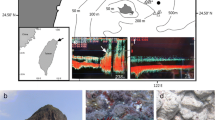Abstract.
Exploration of hydrothermal vent systems in locations remote from well-studied sites allows ecologists to determine the degree of site-specific variation in trophic relationships among communities. A preliminary outline of the trophic structure of the Kairei hydrothermal vent community on the Central Indian Ridge (25°19.23′S; 70°02.42′E) is provided here, based on analysis of collections from an April 2001 expedition. Invertebrate biomass at Kairei is dominated by organic carbon with a δ13C isotopic value of about –13‰, due to the abundance of primary consumers (shrimp: Rimicaris aff. exoculata) and secondary consumers (anemones: Marianactis n. sp.) with this isotopic composition. Filamentous thiotrophic episymbionts on shrimp have been interpreted to be the major diet items of the shrimp and hence are the dominant primary producers within the community. Free-living autotrophic microorganisms are implicated as the dietary base for other invertebrate species. Four trophic groups are identified within the Kairei invertebrates based on carbon- and nitrogen-isotope ratios, but these groups do not always define discrete trophic levels. Ontogenetic shifts in diet are documented for R. aff. exoculata and brachyuran crabs (Austinograea n. sp.). Diets of symbiont-bearing mussels (Bathymodiolus aff. brevior) and two species of gastropods are isotopically constant throughout the range of sizes analyzed. There is a consistent but unexplained pattern of increasing nitrogen isotopic composition with increasing carbon isotopic composition in vent communities from geographically disjunct oceanic regions. Given the assumptions associated with interpretations of isotopic data, there remains a missing pool of carbon (presumably unsampled bacterial biomass) that contributes to the maintenance of the 13C- and 15N-enriched primary consumers in these ecosystems.
Similar content being viewed by others
Author information
Authors and Affiliations
Additional information
Electronic Publication
Electronic Supplementary Material
Rights and permissions
About this article
Cite this article
Van Dover, C. Trophic relationships among invertebrates at the Kairei hydrothermal vent field (Central Indian Ridge). Marine Biology 141, 761–772 (2002). https://doi.org/10.1007/s00227-002-0865-y
Received:
Accepted:
Issue Date:
DOI: https://doi.org/10.1007/s00227-002-0865-y




